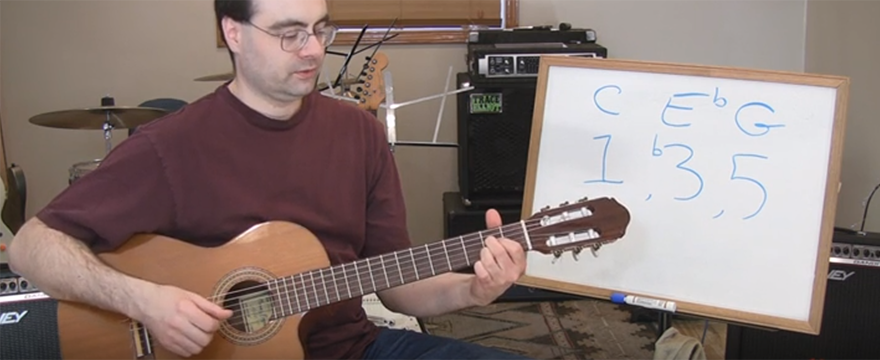Triad chord types are the foundation for all harmony, so they must be understood at a high level. This lesson explains the basic theory of triad chord types, how these chords are constructed, how to name them, as well as, their emotional effects in music.
BASIC THEORY – TRIAD CHORDS:
As their name implies, triad chords are chord types that contain three different notes. The notes that are used in their construction are taken from the major scale.
If we were to use a “C Major Scale” as an example, we could create a “C Major” triad by using the scales first, third and fifth degrees. This “formula” (known as “1, 3, 5”) is used to create the foundation for all triad types. However, when different triad chord qualities, (such as “Minor”), are introduced, the formula would change to reflect the new chord quality.
TRIAD CHORD CONSTRUCTION:
Since a chord (in general) is the result of combining three or more harmonious tones and sounding them together. The 3-note triad chord is the foundation for not only three note chord types, but also for all chords in general.
To construct a triad we add the intervals of a 3rd and a 5th above the lowest chord tone, (the lowest chord tone is called the root).
If we were to use the “C Major Scale” as an example, the first chord tone (Root), would be the tone of, “C.” The second chord tone would be the 3rd of the scale, “E.” The third tone of the chord would be scales 5th degree of, “G.”
When combined, the “C Major Triad,” would consist of the notes, “C, E, G.” All of these tones are taken from the 1st, 3rd and 5th degrees of the “C Major Scale.” When combined together as a chord, they create the triad of “C Major.”

NAMING TRIADS:
A triads name is established when analyzing all of the chord tones from off of the root note. If the upper tones, (the chords 3rd and 5th), correspond to the lower tone (Root note) as diatonic notes of the major scale, the chord is considered as “Major.”
However, if the 3rd or 5th chord tones are altered, we establish other triad types. Aside from the “Major” triad, there are three additional triad qualities in music.
Together, we have a grand total of four different triads in our musical language.
- Major Triads: (1, 3, 5)
- Minor Triads: (1, ♭3, 5) lowered 3rd
- Augmented Triads: (1, 3, ♯5) raised 5th
- Diminished Triads: (1, ♭3, ♭5) lowered 3rd and 5th
HARMONIC EFFECTS OF THE TRIAD:
Chord application of any kind will create different types of emotional effects across a piece of music. When musicians analyze the “emotional effect” of triads (how they will be applied), their effect will fall into one of two categories;
- Consonant:
A stable or relaxing sound which can be used to begin or end a piece of music - Dissonant:
An unstable (tension producing) sound which wants to resolve back into stability
- There are two categories of “Consonant Triad”
Major and Minor - There are two categories of “Dissonant Triad”
Augmented and Diminished
